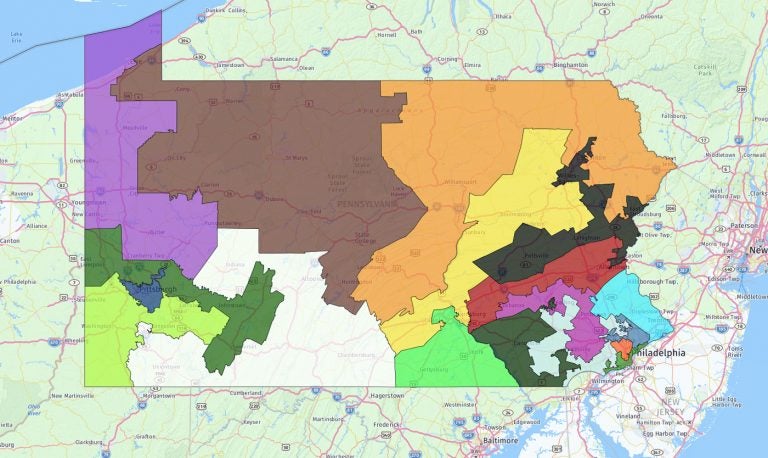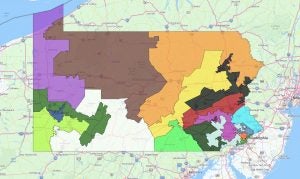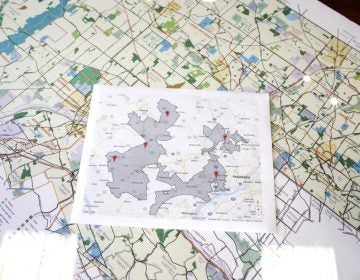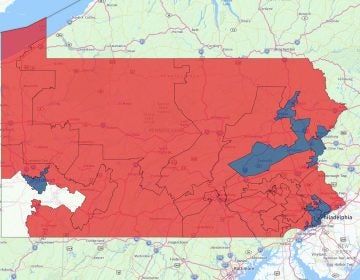Day 2 testimony in gerrymandering lawsuit delves deeper into making Pa.’s congressional map
This week’s Commonwealth Court proceedings will be used to inform the state Supreme Court’s decision on the matter, which is anticipated in January.

Pennsylvania's congressional map as drawn in 2011. In 2018, it was deemed an unconstitutional partisan gerrymander by the Pa. Supreme Court (Keystone Crossroads)
The gerrymandering case that could force a new congressional map continued Tuesday in Harrisburg.
Eighteen Democrats are suing, alleging Pennsylvania’s map – considered the nation’s most gerrymandered, by some measures – was drawn unfairly by state GOP leaders to advantage Republicans.
So far, the minutiae of mapmaking have dominated testimony.
The plaintiff’s first expert witness Jowei Chen has testified that partisan concerns trumped best practices for redistricting based on 1,000 computer-generated alternatives to the state’s current map.
But one of his findings might overlap with counter arguments from the defense’s expert taking the stand later this week.
Congressional maps have to follow certain rules, like distributing voters equally. Advocates for fairer maps say it’s best to avoid splitting municipalities among multiple districts.
Chen says his simulated maps were superior according to some of those best practices. They divided fewer communities, had stronger scores for measures of compactness and contiguity.
They’d also yield a more balanced Pennsylvania congressional delegation. For the last three cycles, Republicans have won 13 out of 18 seats, despite Democrats’ higher voter registration statewide.
The General Assembly used some of those same principles, in addition to other criteria when designing the map in 2011 – but Chen says he doesn’t know what else, exactly, because the defense team wouldn’t disclose the information.
Chen did try putting one extra criteria into his algorithms: protecting incumbents.
The resulting maps were less compact, traversed more county and municipal borders, and would yield more tilted Congressional delegations – albeit, to a lesser degree than Pennsylvania’s actual map.
Lawyer Patrick Lewis, who cross-examined Chen Tuesday, went through several of Chen’s simulated maps designed with protecting incumbents in mind, in addition to the standard principles.
Lewis prompted Chen to confirm that the additional criterion yielded maps that were less compact and included more split communities: counties, municipalities, and even down to the Census block level – although Chen couldn’t speak to whether adding other non-partisan factors to mapmaking criteria would have a similar effect.
The defense also argued later that protecting incumbents is a good thing for Pennsylvania because more senior representatives have more experience and power in congress.
Another plaintiffs’ witness, John Kennedy, a political science professor at West Chester University, disputed that assertion.
“Can you prove it? Power is a relative term and it can be attained in a number of ways,” Kennedy said, pointing to House Speaker Paul Ryan, who’s ranked 81st in congressional seniority.
Kennedy also discussed the anomalies he’s observed in Pennsylvania’s congressional maps and election results over time.
He showed the increasingly abstract shapes of voting districts, some morphing to include geographically disparate communities, but he acknowledged that strange boundaries don’t necessarily reflect gerrymandering.
He says Pennsylvanians identify strongly with the region where they live (the Lehigh Valley, Harrisburg, Scranton, etc.), which makes the division of communities by gerrymandering more relevant.
And he delved into how the partisan spread is distinctly different within several districts, using gradient maps showing precinct-level vote totals from the 2010 Senate race in which Democrat Joe Sestak unsuccessfully challenged Republican Senator Pat Toomey, who won another term last year.
But the defense dismissed Kennedy’s conclusions because they rely on results from an election before the current map existed.
This week’s Commonwealth Court proceedings will be used to inform the state Supreme Court’s decision on the matter, which is anticipated in January.
WHYY is your source for fact-based, in-depth journalism and information. As a nonprofit organization, we rely on financial support from readers like you. Please give today.







